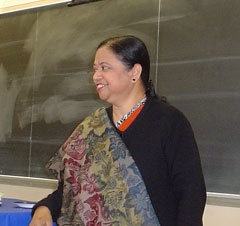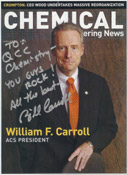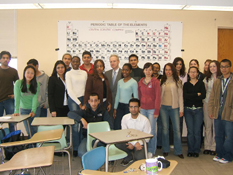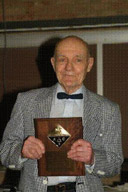Chemistry Department Events
Distinguished Visitors to Chemistry Department at QCC

Dr. Nazmunnessa Mahtab
(Fulbright Scholar)
Dr. Nazmunnessa Mahtab, Professor and Chair of the Department of Women's Studies and Former Professor at the Department of Public Administration at the University of Dhaka in Dhaka, Bangladesh was the first ever Fulbright Scholar to visit and spend time in our college. Dr. Mahtab came to the Chemistry Department on Friday November 4 and addressed our faculty and students. Our students, who are almost exclusively immigrants, appreciated her visit because they could relate to the hardships that she has encountered and in her they see a role model.




Distinguished Chemists That Have Visited QCC
Dr. William F. Carroll
(2004 American Chemical Society President)


He visited QCC on April 1, 2005 and addressed our students who were thrilled to meet and talk with him. Dr. Carroll dedicated an autographed cover of a Chemical and Engineering News issue to the Chemistry Department.
Dr. John B. Fenn
(2002 Chemistry Nobel laureate)

He was invited by the Chemistry Department to address the student presenters at the 52nd Undergraduate Research Symposium of the ACS-NY section on May 1, 2004. Dr. Fenn is showing the plaque presented to him by the QCC students.
Dr. Alan MacDiarmid
(2000 Chemistry Nobel laureate)

He visited our campus on November 9, 2004 and addressed QCC faculty and students. Our own faculty Dr. David Sarno worked with Dr. MacDiarmid for 18 months before joining Queensborough and was the person to invite him to our campus.






Department Seminar - Chemistry Department
Thursday, February 4, 2016, 6:00 PM (The LI-ACS Seminar)
Room S-112
Dr. Robert Engel (Department of Chemistry and Biochemistry, Queens College - CUNY)
Antimicrobial Surfaces
Efforts in the Engel laboratory have been directed toward the development of environmental surfaces that kill bacteria and fungi on contact without the use of antibiotics that can lead to the development of resistant strains. We describe our approach toward this end that utilizes cationic lipids for the rapid and complete destruction of a wide range of bacteria (Gram negative and Gram positive) as well as fungi, without being consumed in the process. Thus, an initial application to the surface remains active throughout the normal lifetime of the surface. Such surfaces serve for the prevention of transmission of pathogens and as such are prophylactic. We describe most recent advances in the application of these techniques toward the destruction of viral species, as well as approaches toward the development of materials that have the potential for use as pharmaceutical agents instead of prophylactic agents.
Friday, February 26, 2016, 1:00 PM
Room M-136
Dr. Deb N. Chakravarti (Department of Chemistry, York College, CUNY)
Vaccines: How They Save Lives
Thursday, March 3, 2016, 6:00 PM (The LI-ACS Seminar)
Room S-112
Dr. Stephen Fearnley (Department of Chemistry, York College)
Heterocyclic Methodology for Natural Products Synthesis
As a synthetic organic chemist, my research program involves the ongoing development of new synthetic methodology for the construction of biologically active natural products. Specifically, this encompasses: 1. Investigation and use of oxazolone as a useful heterocyclic scaffold for alkaloid synthesis: This has primarily involved studies of intramolecular Diels-Alder reactions with oxazolone as the dienophilic species. Extrapolation to other cycloadditions is planned. Application in the synthesis of several alkaloid targets is currently underway. 2. Novel organosilane chemistry for approaches to bioactive ether targets: We have developed a rapid synthesis of cis-fused bicyclic ether arrays in which oxoniums undergo nucleophilic attack by vinylsilanes in a novel intramolecular annulation process. The related silyl-activated Friedel-Krafts process proceeds through an unusual combination of electronic and steric effects. A series of silicon-mediated cycloadditions are also under investigation. A wide variety of ether natural product motifs are thus accessible.
Friday, March 11, 2016, 12:10 PM
Room M-136
Dr. Elise Champeil (John Jay College of Criminal Justice, CUNY)
Correlation between the structures of MC and DMC DNA crosslinks and the role of p21 in the toxicity of DNA adducts.
The mode of action of Mitomycin C (MC) to treat certain cancers is known in contrast to 10-decarbamoyl mitomycin C (DMC) which has recently been found to form similar or identical adducts with DNA as mitomycin C (MC). DMC however generates a unique stereoisomeric interstrand crosslink (beta isomer, β-ICL) and its DNA-adduct generated by DMC treatment (-ICL) rapidly activate a p53-independent signal transduction pathway. The central hypothesis of this proposal is that the differences in the local DNA structures of the mitosene-alpha and mitosene-beta crosslink adducts (-ICL and -ICL) are responsible for the different biochemical responses produced by the two compounds. In particular, we hypothesize that DMC provokes a PI3K/Akt/p21 cell death pathway due to the specific DNA-adducts formed. In order to correlate MC and DMC-adducts structures with the role of p21 in the toxicity of the α-ICL and β-ICL, the following three aims will be achieved: 1) Synthesis of the alpha and beta DNA crosslinks of MC and DMC via biomimetic and post-oligomerization methods. 2) Determination of the sequence selectivity (CG or GC) for the -ICL of decarbamoyl mitomycin C (DMC) through analysis of the favored cross-linking pathway. This will reveal the orientation of the drug in the DNA duplex: upstream or downstream. 3) Finally, the role of p21 in the upstream p53-independent signaling pathway in response to MC/DMC and these crosslinks will be determined by using flow cytometry to verify the cell cycle arrest stage, Western blot analysis to reveal the p21 phosphorylation status and immunocytochemistry to localize p21.
Friday, March 11, 2016, 2:00 PM
Room S-414
Dr. Raquel Castellanos (John Jay College of Criminal Justice, CUNY)
The Forensics Program at John Jay College of Criminal Justice
Research Outreach Coordinator at the Program for Research Initiatives in Science and Math (PRISM)
Thursday, April 7, 2016, 6:00 PM (The LI-ACS Seminar)
Room S-112
Dr. Gene Hall (Department of Chemistry and Chemical Biology, Rutgers University )
From Archimedes Palimpsest to Water Analysis: My 37 Years of Instrumental Analytical Chemistry at Rutgers
My presentation will focus on my 37 years of analytical chemistry in the Chemistry Department at Rutgers, The State University of New Jersey. I will share with you some of the exciting research projects that I have been involved with based upon the use of several analytical instruments (Raman, GC-FID/MS, TOF- MS/MS, EDXRF, FT-IR, HPLC, and TLC-FID) in my toolbox. In addition, teaching has been an exciting way to pass on my knowledge to up-and-coming students wishing to pursue a career in analytical chemistry. My research has three areas of focus that include environmental, biological, and forensic. In environmental analysis, I will share with you my experience with ICP-MS for tap water analysis to determine sources of Pb by measuring its stable isotopes. Furthermore, using ICP-MS in biological applications, we report on blood lead analysis from a gunshot victim in which Pb-based bullet fractions remain lodged in the subject's body. By measuring the stable Pb isotope ratios in sequential blood samples and comparing these ratios with the lead-based bullet, interesting kinetics of Pb exchange can be determined. Recently, we have been using shotgun lipidomics to analyze designer omega-3 fatty acid dietary supplements used to provide the bioactive molecule DHA to Alzheimer's patients. Forensic science has also been an exciting venture in our laboratory. In this regard, I will share you our micro EDXRF method to recover text, non-destructively of course, for the first time on pages from the Archimedes Palimpsest. Keeping with the theme of micro analytical chemistry, results using Raman microscopy, micro ATR-FTIR, and micro EDXRF, will be presented. Specific examples, non-destructively, of analyzing postage stamps, jewelry (counterfeit Rolex watches), counterfeit US and British banknotes, Coach handbags, mouse embryos, and krill will be presented. Use of chemometrics with digital spectral libraries and database mining software assisted in rapid characterization of unknown artifacts. Analytical chemistry with an extensive tool-box of state-of-the-art instrumentation is fun and exciting. Therefore, in this presentation, sharing our specific applications described above will be fun and enjoyable.



